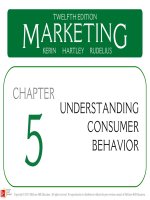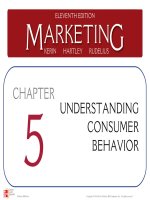Lecture Marketing: The core (5/e): Chapter 3 – Kerin, Hartley, Rudelius
Bạn đang xem bản rút gọn của tài liệu. Xem và tải ngay bản đầy đủ của tài liệu tại đây (2.95 MB, 43 trang )
McGrawHill/Irwin Copyright © 2013 by The McGrawHill Companies, Inc. All rights reserved.
LEARNING OBJECTIVES (LO)
AFTER READING CHAPTER 3, YOU SHOULD BE ABLE TO:
LO1
Explain the purpose of environmental
scanning.
LO2
Describe social forces such as
demographics and culture.
LO3
Discuss how economic forces affect
marketing.
LO4
Describe how technological changes
can affect marketing.
32
LEARNING OBJECTIVES (LO)
AFTER READING CHAPTER 3, YOU SHOULD BE ABLE TO:
LO5
Discuss the forms of competition that
exist in a market.
LO6
Explain how regulatory forces ensure
competition and protect producers and
consumers.
LO7
Identify factors that influence ethical
and unethical marketing decisions.
LO8
Describe the different concepts of
social responsibility.
33
WHAT IS THE WORLD’S THIRD LARGEST NATION?
THE SOCIAL NATION CREATED BY FACEBOOK!
34
FIGURE 3-1 Environmental forces affect the
organization, its suppliers, and its customers
35
LO2
SOCIAL FORCES
DEMOGRAPHICS—POPULATION
Environmental Scanning
Social Forces
Demographics
• Population at a Glance
Population Explosion
• U.S. Population
36
LO2
SOCIAL FORCES
DEMOGRAPHICS—GENERATIONAL COHORTS
Baby Boomers: 1946 - 1964
Generation X: 1965 - 1976
Generation Y: 1977 - 1994
Millennials: 1995+
37
LO2
Ameritrade, American Airlines, and HTC
Which generational cohort is being reached?
38
LO2
MAKING RESPONSIBLE DECISIONS
Millennials Are Going to Change the World!
39
LO2
SOCIAL FORCES
DEMOGRAPHICS—RACIAL & ETHNIC DIVERSITY
Composition
Trends
• African Americans
• Hispanics
• Asian Americans
Multicultural
Marketing
310
LO2
SOCIAL FORCES
DEMOGRAPHICS—THE AMERICAN HOUSEHOLD
Marital Status
Cohabitation
Blended Family
311
LO2
SOCIAL FORCES
DEMOGRAPHICS—POPULATION SHIFTS
Regional Shifts in the U.S.: 2012
312
LO2
SOCIAL FORCES
DEMOGRAPHICS—POPULATION SHIFTS
Shifts Within States
• Rural
• Cities
• Suburbs
• Exurbs
313
LO2
SOCIAL FORCES
DEMOGRAPHICS—POPULATION SHIFTS
Statistical Areas (SA): Illinois
• Combined SA: NE Illinois
• Micropolitan SA: Dixon, IL
• Metropolitan SA: St. Louis, MO & SW IL
• Metropolitan Division: Chicagoland
314
SOCIAL FORCES
LO2
CULTURE
Culture
Cultural Values
315
LO3
ECONOMIC FORCES
MACROECONOMIC CONDITIONS
Economy
• Inflation
• Recession
316
LO3
ECONOMIC FORCES
CONSUMER INCOME
Gross Income
Disposable Income
Discretionary Income
317
LO4
TECHNOLOGICAL FORCES
TECHNOLOGY OF TOMORROW
Technology
• Social Networks
• Natural User Interfaces
• Green Infrastructure
• Biotechnology
• Tablet Devices, Etc.
318
LO4
TECHNOLOGICAL FORCES
IMPACT ON CUSTOMER VALUE
Impact on Customer Value
• Plummeting Costs
• New Products
Marketspace
Electronic Commerce
319
LO4
New Yorker, GoToMeeting, and Spot Connect
What products might be replaced with these?
320
LO5
COMPETITIVE FORCES
ALTERNATIVE FORMS OF COMPETITION
Competition
• Pure Competition
• Monopolistic Competition
• Oligopoly
• Pure Monopoly
321
FIGURE 3-A Continuum of competition
322
LO6
REGULATORY FORCES
FEDERAL LEGISLATION
Regulation
Protecting Competition
• Sherman Antitrust Act (1890)
• Clayton Act (1914)
• Robinson-Patman Act (1936)
323
LO6
REGULATORY FORCES
FEDERAL LEGISLATION
Protecting Producers and
Consumers
• Patent Law
• Copyright Law
• Digital Millennium Copyright Act (1998)
• Nutritional Labeling
324
LO6
REGULATORY FORCES
FEDERAL LEGISLATION
Protecting Producers and
Consumers
• Consumer Product Safety Act (1972)
• Consumer Product Safety Commission
• Consumerism
325









